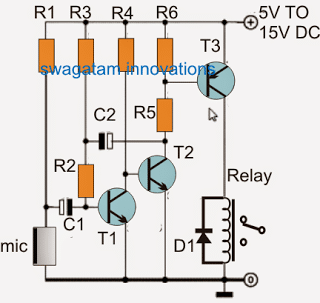In this post I have explained 3 simple sound activated relay switch circuits which can used as a module for any system that might be assigned to trigger by detecting some kind of sound pressure level. Or simply applications such as a voice activated alarm security circuit.
1) Circuit Objective
Utilizing this basic sound activated switch design, toggling a system by a sound pulse could be done very effectively, not only with a robotic system but as well as for any desired of home automation.
As an illustration the circuit could be used like a sound-activated light bulb to illuminate a porch light in response to a knock on the front door.
This light would then switch off automatically after some delay. An optional implementation may be in the form of a security protection system.
In this system whenever an intruder aspires to break open the front door or steal a thing, the sound vibrations made during the robbery could then light a bulb or sound an alarm, quickly indicating that someone uninvited has visited your home.
The circuit could work from any 5-12 VDC controlled power source as long as a relay with the appropriate coil voltage is employed.
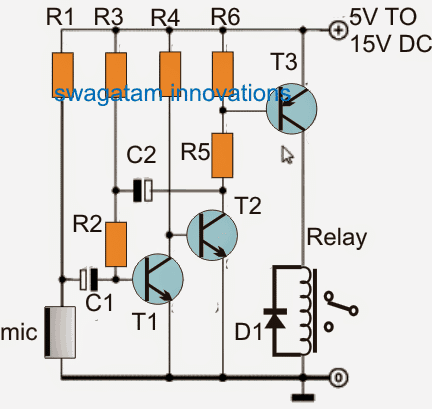
Video Demonstration
How it Works
As soon as the sound activated switch circuit is powered ON, you might find the relay activating briefly due to the presence of capacitor C2.
After this, whenever you create a noise in front of the MIC, the relay is going to activate briefly depending on the value of C2 and then switch OFF.
Any AC or DC load connected with the relay contacts will subsequently switch ON and OFF in response to the relay switching.
A couple of seconds must be allowed for the relay to be toggled off. If felt necessary you could to increase or decrease the ‘on’ time period of the relay by modifying the uF C2.
A larger uF contributes to an extended ‘on’ period, and the opposite way round. However, you should not employ a value exceeding beyond 47μF.
Biasing resistor R1 becomes the main part which decides how sensitive the MIC or the microphone can be. Lower values will increase the sensitivity of the MC and the circuit, and vice versa.
An electret microphone commonly possesses just one central FET inside which strictly requires a bias voltage to function.
The best possible R1 value for effective response to audio or noise signal could be determined only through some practical experimentation.
All of the related and essential electronic protection precautionary measures is required to be implemented each time a mains AC powered load is to be connected with the relay contacts.
Parts List
- R1 = 5k6
- R2 = 47k
- R3 = 3M3
- R4 = 33K
- R5 = 330 OHMS
- R6 = 2K2
- C1 = 0.1uF
- C2 = 4.7uF/25V
- T1, T2 = BC547
- T3 = 2N2907
- D1 = 1N4007
- Relay = coil voltage as per the supply voltage, and contact rating as per the load specs
- Mic = electret condenser MIC.
Applications
The concept can be used as a vibration activated LED lighting, for sound triggered recording systems. It can also used as a sound toggled night bedroom light circuit
2) Sound Activated Switch with Customized Sound Frequency
The next project below explains a simple, accurate remote control system through sound vibration that will work on a particular sound frequency.
Therefore it's perfectly foolproof since it won't be disturbed through other unwanted sound or noise.
The idea was requested by Mr. Sharoj Alhasn.
The Sound Sensor Circuit
The figure shows the circuit of a sound detector circuit which can be effectively converted into a remote control, triggered using a sound generator handset.
We have already learned a lot regarding this wonderful frequency decoder LM567 IC.
The IC will lock-on into any frequency that's fed across its input and which exactly matches the frequency fixed across its pin5 and pin6 via the relevant R/C components.
The formula for determining the latching frequency across pin5/6 may be calculated using the following formula:
F = 1 / R3xC2,
where C is in farads, R is in Ohms while F is in Hz.
Here it's set to around 2kHz.
Pin3 is the input of the IC which tracks, responds and locks on an frequency which may be reaching the 2kHz figure.
Once the IC detects this, it produces a zero logic or an instant low at its output pin8.
This low at pin8 sustains as long as the frequency at the input pin stays active, and becomes high as soon as it's removed.
Circuit Diagram
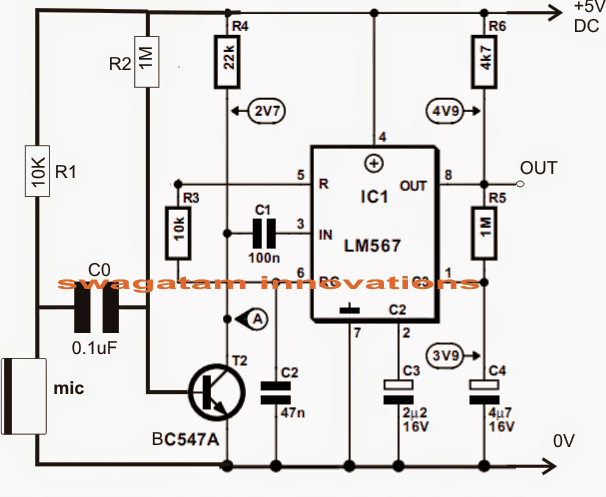
In the discussed sound triggered remote control circuit, a MiC is configured across pin3 of the IC.
An external matching frequency (2kHz) in the form of an audible sound or whistle is pointed toward the mic such that the sound hits the mic starighton.
The mic converts the sound into electrical pulses corresponding to the received frequency at the relevant input pin of the IC.
The IC immediately acknowledges the matching data and reverts the output into a low for the necessary actions.
The output may be directly connected with a relay if only a momentary toggling is required or only for the time the input is active.
For an ON/OFF switching the same may be configured with a FLIP-FLOP circuit.
Sound Activated Remote Transmitter Circuit
The following circuit may be utilized for generating an audible frequency for the above described sound remote receiver circuit.
The circuit is based on a simple AMV concept using a few ordinary transistors and some other passive parts.
The frequency of this transmitter circuit must be first set to the receivers matching frequency which is calculated to be 2kHz.
This may be done by suitably adjusting the 47k preset and monitoring a latching response from the receiver simultaneously.
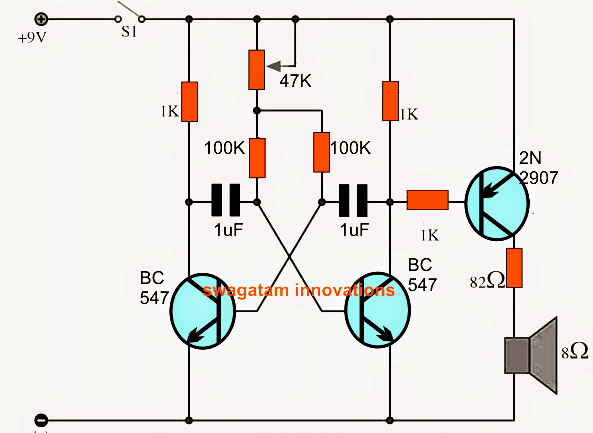
Applications
The above explained project which uses foolproof unique frequency for sound triggering can be specifically for remote locks in cars, house doors or safes for jeweler's shops and office entrances etc
3) Alarm Trigger with Sound using Piezo
So far have learn regarding ON/OFF application using noise generation, now let's see how the same could be used for triggering an alarm, whenever a noise or a sound is detected.
A simple sound triggered alarm circuit is a device which is used for triggering an alarm on detection of a sound vibration. The sensitivity of the unit is set externally according to the requirement of the user.
The circuit discussed in this article can be implemented for the above purpose or simply as a security device for detecting an intrusion. For example it can be fitted in a car for detecting a possible intrusion or a break-in.
Looking at the circuit diagram we see that the circuit uses only transistors and therefore becomes very easy even for a new hobbyist to understand and make the system at home.
How it Works
Basically the whole circuit is made up of two small signal amplifiers which are connected in series for doubling the sensing power.
T1, T2 along with the associated resistors becomes the first small signal amplifier stage.
The introduction of the 100K resistor across the emitter of T2 and the base of T1 plays an important role in making the amplifier stage very stable due to the feedback loop connected from the output to the input of the stage.
The input of T2 is connected to a piezo transducer element, which is used as a sensor here.
Sound signals hitting the piezo transducer surface is effectively converted to tiny electrical pulses which are amplified by the amplifiers made from T1 and T2 to a certain higher level.
This amplified signal which becomes available at the collector of T2, is fed to the base of a high gain PNP transistor T3 via the 47uF coupling capacitor.
T3 further amplifiers the signals to yet higher levels.
However, the signals are still not strong enough and won't detect the minute sound vibrations, probably which might be emitted by human physical contacts over a particular body.
The next stage which is a replica of the first stage, consists of the transistor T4 and T5.
The amplified signals generated at the collector of T3 is further coupled to the above stage for the final processing.
T4 and T5 makes sure that the signals are amplified to the required limits as per the units expectations.
If the piezo is attached to, say for example a door, even a slight knock over the door will be easily sensed and the alarm connected to T5 will become active.
The 10uF capacitor across the 10K preset keeps the alarm activated for a few seconds of time, its value may be increased for increasing the above delay of the alarm sound.
The discussed sound activated alarm circuit will work with any supply in between 6 and 12, however if the alarm is a powerful one, the current might have to be selected accordingly.
The preset may be used for setting the sensitivity of the circuit.
Circuit Diagram

For the sensor, a 27mm piezo transducer will work the best, the following figure shows the image of this device:
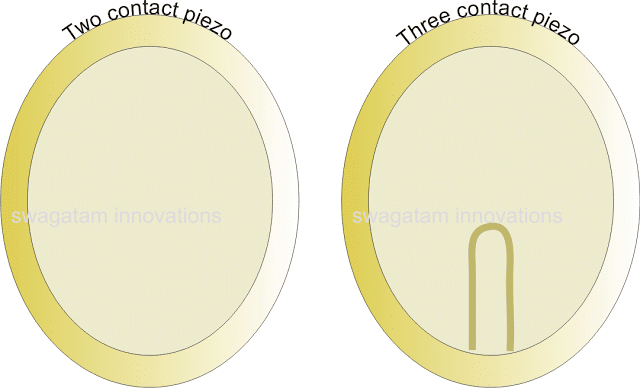
Applications
The sound vibration operated switch as explained above looks suitable for creating alarm or siren alarms in response to sound vibrations and therefore could be installed under mats or fixed on doors as safety alarm units.
Whenever a intruder or thief tries to trespass the area by stepping on the mat or opening the door, the sound activates the alarm allowing the user and the neighboring people to get warned about the break-in.
